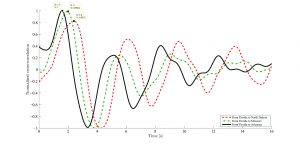A DATA-DRIVEN APPROACH TO ESTIMATED FREQUENCY DISTURBANCE PROPAGATION SPEED IN THE INTERCONNECTED POWER SYSTEM
PhD Student Phuc Huynh with Advisor Hao Zhu

Figure 40: Estimated propagation time (corresponding to the peak location) from Florida to other locations in the Eastern Interconnection: 2.4 seconds to North Dakota (compared to the 2.5 seconds recorded), 2 seconds to Missouri (compared to the 2.1 seconds recorded), and 1.6 second to Arkansas (compared to the 1.5 seconds recorded)
When a big disturbance occurs at one location in a large-scale power system, very shortly afterwards other locations (even thousands of miles apart) will be affected. In severe cases, blackouts could be widespread. At around 6 pm on February 26, 2008, a blackout occurred in Florida. Millions of people lost power and several utility companies could not control their assets. Almost immediately after this event, grids across the Eastern Interconnection (this interconnected power system reaches from Central Canada eastward to the Atlantic coast [excluding Quebec], south to Florida, and back west to the foot of the Rockies [excluding most of Texas][1]) observed frequency oscillations. If the oscillations had been severe (which was not the case but might be in the future), blackout could be widespread because the system would try to shed load to balance the frequency. To prevent such a blackout, system operators need to know how much time remains before their system is hit by the disturbance, i.e., the disturbance propagation time. Quickly performed preventive actions could save the grid from a widespread blackout.
We propose a data-driven method to estimate propagation time of the frequency disturbance between various locations. Our method provides two major advantages: (i) it does not rely on detailed power system dynamic models, which are usually missing, inaccurate or confidential; and (ii) it could be performed online. Those advantages make this method capable of discovering the physical property of the system without having to know all the system details. If the system changes physically (e.g., adding/removing load, generators, transmission lines, etc.) or operates at a different operating point, the disturbance propagation time could be updated accordingly without having to precisely identify the new system condition. We analytically proved the method’s validity using a system modeled by the second-order dynamic and validated it using real frequency measurements from the 2008 Florida blackout, as shown in Figure 40 . The validation suggests that our method has a high degree of accuracy for estimating frequency disturbance speed across the Eastern Interconnection.